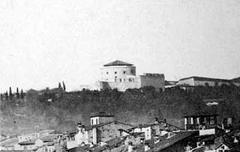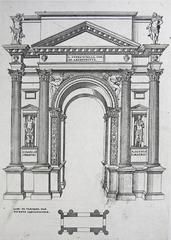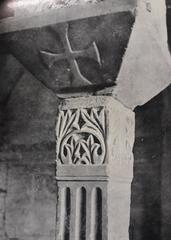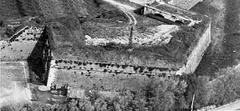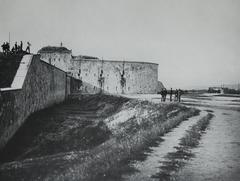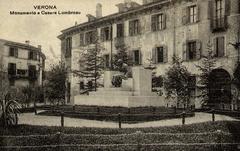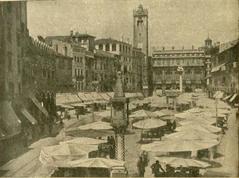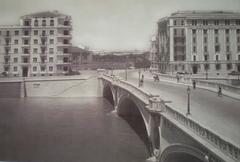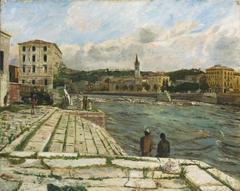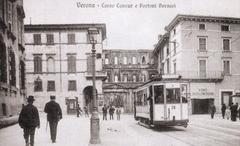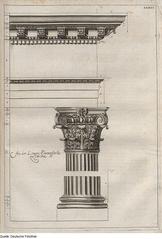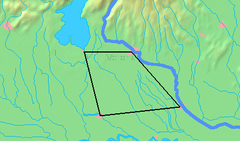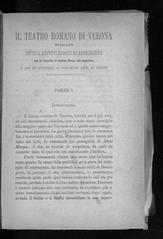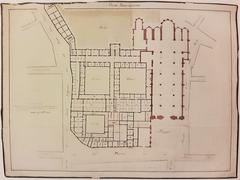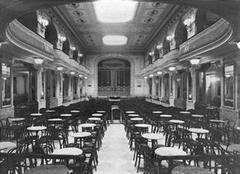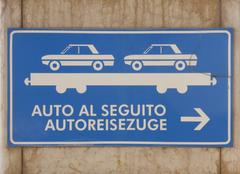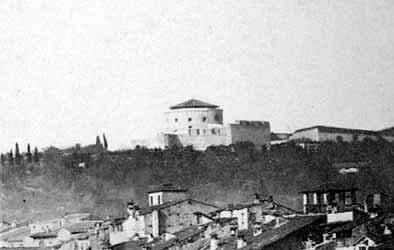
Visiting Forte Sofia in Verona: Hours, Tickets, and Tips
Date: 01/08/2024
Introduction
Forte Sofia, located in the picturesque hills of Verona, Italy, is a remarkable historical fortification that offers visitors a unique insight into the city’s extensive military history and architectural heritage. Constructed between 1837 and 1843 under the guidance of Major General Franz von Scholl, Forte Sofia was part of a broader defensive strategy orchestrated by the Austrian Empire to protect Verona from northern invasions (source). Named after Archduchess Sofia of Bavaria, the fort stands as a testament to the strategic and architectural ingenuity of the time. Although currently in a state of partial abandonment, recent restoration efforts and community-driven initiatives aim to revive this historical site for public engagement and education. This comprehensive guide will delve into the origins, strategic significance, and architectural marvels of Forte Sofia, while also providing practical visitor information and travel tips to enhance your visit to this hidden gem in Verona.
Table of Contents
- Introduction
- Origins and Construction
- Strategic Importance
- Architectural Features
- Role in Verona’s Defensive System
- Historical Context
- Decline and Abandonment
- Restoration Efforts
- Cultural and Historical Significance
- Visitor Information
- Travel Tips
- FAQ
- Conclusion
Explore Forte Sofia: Visiting Hours, Tickets, and Historical Significance in Verona
Origins and Construction
Forte Sofia, originally named Werk Sofia, is a significant historical fortification located in the hills of Verona, Italy. The fort was constructed between 1837 and 1843 as part of Verona’s extensive defensive system. The design and construction were overseen by the German Major General Franz von Scholl, who was the director of the Imperial Royal Office of Fortifications in Verona. The fort was dedicated to Archduchess Sofia of Bavaria, the mother of Emperor Franz Joseph, hence its name (source).
Strategic Importance
The strategic importance of Forte Sofia cannot be overstated. Positioned on the San Leonardo hill, north of the River Adige’s horseshoe bend, the fort was a crucial part of Verona’s defensive network. This network was designed to protect the city from northern invasions and to serve as a stronghold during times of conflict. The fort was capable of housing up to 150 infantrymen and 24 gunners, with 14 smoothbore guns (source).
Architectural Features
Forte Sofia is an architectural marvel, featuring a central circular tower surrounded by a perimeter wall with three defensive structures, including a caponier. The main front of the fort is characterized by an arc-shaped earthwork with open-air artillery positions, protected by sturdy masonry parapets. A dry moat, now covered by vegetation, separates the fort from the adjacent hill, which is shaped in a geometric spalt form to allow for low-angle artillery fire. Inside the tower, visitors can explore three floors connected by a double helical staircase, showcasing intricate design and craftsmanship (source).
Role in Verona’s Defensive System
Forte Sofia was part of a larger defensive system that included city walls, bastions, forts, entrenched camps, warehouses, and barracks. This system was built between 1814 and 1866 during Habsburg rule, making Verona a pivotal stronghold in the Empire’s strategic network. The city of Verona, due to its strategic location at the crossroads between the Alps and the rest of Italy, has always been a significant military hub. This importance is reflected in the numerous fortifications and military structures that dot the city (source).
Historical Context
Verona’s history as a fortified city dates back to Roman times. The city’s location at the mouth of the Adige Valley, the main communication route between Italy and Germany, made it a strategic center. Throughout history, Verona has been a crossroads of three consular roads: the Via Claudia Augusta, the Via Postumia, and the Via Gallica. This strategic importance continued through the Middle Ages and into the modern era, with various powers, including the Ostrogoths, Lombards, Franks, the Republic of Venice, Napoleonic France, and Austria, vying for control of the city (source).
Decline and Abandonment
Despite its initial importance, Forte Sofia eventually fell into disuse and ruin. The fort, now abandoned, is surrounded by parked cars and overgrown vegetation. The moat is dried up, and the interior of the fort is not accessible to visitors. However, the exterior remains a testament to its historical significance and architectural beauty. The fort’s decline mirrors the broader changes in military technology and strategy that rendered such fortifications obsolete (source).
Restoration Efforts
In recent years, efforts have been made to restore Forte Sofia and preserve its historical and cultural significance. The Association of Social Promotion Forte Sofia is leading a restoration project aimed at reviving the fort and making it accessible to the public. Donations and support from history enthusiasts and the local community are crucial for the success of this project. Details for donations can be found on the association’s website (source).
Cultural and Historical Significance
Forte Sofia is more than just a military fortification; it is a symbol of Verona’s rich history and strategic importance. The fort offers breathtaking views of the Adige River, the city walls, and the surrounding countryside. It stands as a reminder of the city’s military past and its role as a crossroads of cultures and civilizations. The fort’s architectural features and historical significance make it a must-visit destination for history buffs and architecture enthusiasts alike (source).
Visitor Information
While the interior of Forte Sofia is not accessible, visitors can still explore the exterior and enjoy the panoramic views from the fort’s platform. The best time to visit is during the spring and summer months when the weather is pleasant, and the surrounding landscape is in full bloom. However, the fort’s charm is not limited to a particular season, and it can be equally enchanting during the autumn and winter months.
- Visiting Hours: Open daily from 10 am to 6 pm.
- Tickets: Free entry to the exterior. Donations are encouraged to support restoration efforts.
- Special Events and Tours: Check the Association of Social Promotion Forte Sofia’s website for updates on guided tours and special events.
Travel Tips
- Getting There: Forte Sofia is accessible by car, bike, or a short hike from the city center. Parking is available nearby.
- What to Bring: Wear comfortable walking shoes and bring water, especially during the summer months.
- Nearby Attractions: After exploring Forte Sofia, visit other nearby historical sites such as Castelvecchio, the Roman Theater, and the Verona Arena.
FAQ
Q: Is there an entrance fee for Forte Sofia?
A: No, entry to the exterior is free, but donations are encouraged to support restoration efforts.
Q: Can I visit the interior of Forte Sofia?
A: Currently, the interior is not accessible to the public due to safety concerns and ongoing restoration efforts.
Q: Are there guided tours available?
A: Yes, guided tours are occasionally offered. Check the Association of Social Promotion Forte Sofia’s website for schedules and details.
Conclusion
Forte Sofia is more than just a relic of Verona’s military past; it is a symbol of the city’s resilience and strategic importance through various historical epochs. Despite its current state of abandonment, the fort’s architectural grandeur and historical significance make it a must-visit destination for history enthusiasts and architecture lovers alike. Ongoing restoration efforts, spearheaded by the Association of Social Promotion Forte Sofia, are crucial in preserving this cultural landmark for future generations (source). By visiting Forte Sofia, you not only immerse yourself in the rich tapestry of Verona’s history but also contribute to the preservation of this invaluable heritage. Whether exploring its exterior, participating in guided tours, or simply enjoying the panoramic views, a visit to Forte Sofia promises to be an enlightening and memorable experience.
References
- Live the World. Forte Sofia. Retrieved from livetheworld.com.
- Laugh Travel Eat. Secret Spots in Verona Off the Beaten Path. Retrieved from laughtraveleat.com.
- Wikipedia. Verona Defensive System. Retrieved from en.wikipedia.org.
- Volotea. When Verona Was the Frontier of the Austrian Empire. Retrieved from volare.volotea.com.
- UNESCO World Heritage Centre. City of Verona - UNESCO World Heritage Centre. Retrieved from whc.unesco.org.
- Viator. Verona Walking Tours. Retrieved from viator.com.
- Verona Tourism. Official Tourism Website. Retrieved from turismoverona.eu.
